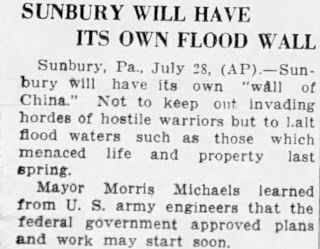Before The Flood Wall - River Park at Arch Street, Looking South, March 1948

More than 40 serious floods have been recorded between 1736 and 1977, in Sunbury, Pa. The Indians used to say that the area would flood every 14 years, and they weren't far off.
To deal with the flooding in Sunbury, a flood wall and levee had been proposed repeatedly by congressmen from Pennsylvania. But there was never enough money. In 1935, as part of the New Deal, the flood wall was once again being discussed.
Then 1936 the river rose to an unprecedented 26.85 feet. The damage and destruction was incredible, with more than four million dollars worth of damage.
(See Photos of the 1936 Flood here )
(See Photos of the 1936 Flood here )
1937
It was decided by congress that Sunbury would get a flood wall, in 1937. But construction would not begin nearly 10 years, and Sunbury would flood twice more before it was built.
The formal ground breaking was August 7 1946 at 11 am, and it was followed by a luncheon for honored guests at the Hotel Edison.
Much of the delay had came from funding issues. Congress originally had earmarked $93,000 for the project. Then when the Army Corp of Engineers was done with their report, and suggested additions, they estimated it would take ten times that amount - or nearly one million dollars. In 1941, there was still no fund created for this project. And in December of 1941, the Japanese bombed pearl harbor, and our country entered World War II.
But finally, in 1946, ground was broken, and construction on Sunbury's flood wall began.
Nothing about the project went smoothly.
Not everyone wanted a flood wall to begin with. Surprisingly, those who were flooded the worst, the homes on front street, were the most opposed - ad they did not want to give up their view of the river.
Then there were the rats, disturbed from their river bed homes, they scurried into the town and were a problem for the residents and businesses for quite awhile.
In the spring of 1947, construction was delayed for a full month, by wet weather.
In the spring of 1947, construction was delayed for a full month, by wet weather.

But the wall was finally competed in 1951. Total cost was 6.6 Million dollars. That's more than 70x the original 1937 budget of 93,000, but it was also a much larger project than originally anticipated. on January 10 1951, the flood protection system was formally turned over to the city of Sunbury.
In May of 1951, 33 evergreen trees were planted along the new riverfront park, and rose bushes and a variety of gardens were planned to beautify the area. The fire company would water the trees and plants during the dry season that year.
The wall got it's first test run before it was officially completed. In November of 1950, the river crested at 18.68 feet. Stores who usually saw water at 15 feet were completely dry, and happy with the new Sunbury Flood Protection. The wall again held back the river in 1960, and then, just barely, in 1972.
In 1972, the flood waters came within two inches of overflowing the wall. But the wall held.

=================
Find More Local History & Stories Here:
https://susquehannavalley.blogspot.com/p/history.html
======================
Read More
=========================
In 1972, the flood waters came within two inches of overflowing the wall. But the wall held.

=================
Find More Local History & Stories Here:
https://susquehannavalley.blogspot.com/p/history.html
======================
Read More
=========================
Construction of the pump house
See modern, color, photos of the completed pump house here:
"The project provided for the construction of a system of levees and concrete floodwalls with a total length of 26,624 feet. Structures for the disposal of interior drainage consisting of six pumping stations, eight interceptor sewers, and other minor relief outlets...." http://sunburyfloodcontrol.com/project-background.html





















Very well done. In 1972 the Susquehanna didn’t overflow the wall because the dyke in Wilkesbarre broke allowing the river
ReplyDeleteto spread out across the Wyoming Valley. This caused the river level, the water at the time was almost at the top of the wall, at Sunbury to drop 3 feet. When the river finally reached its crest it was back at the top of the wall.